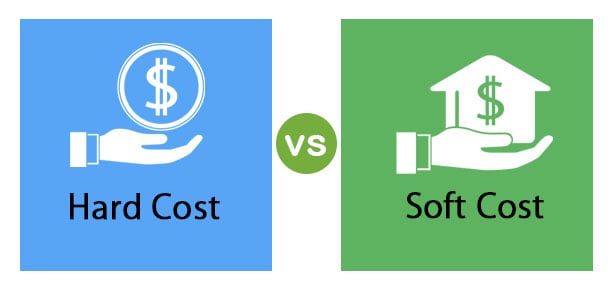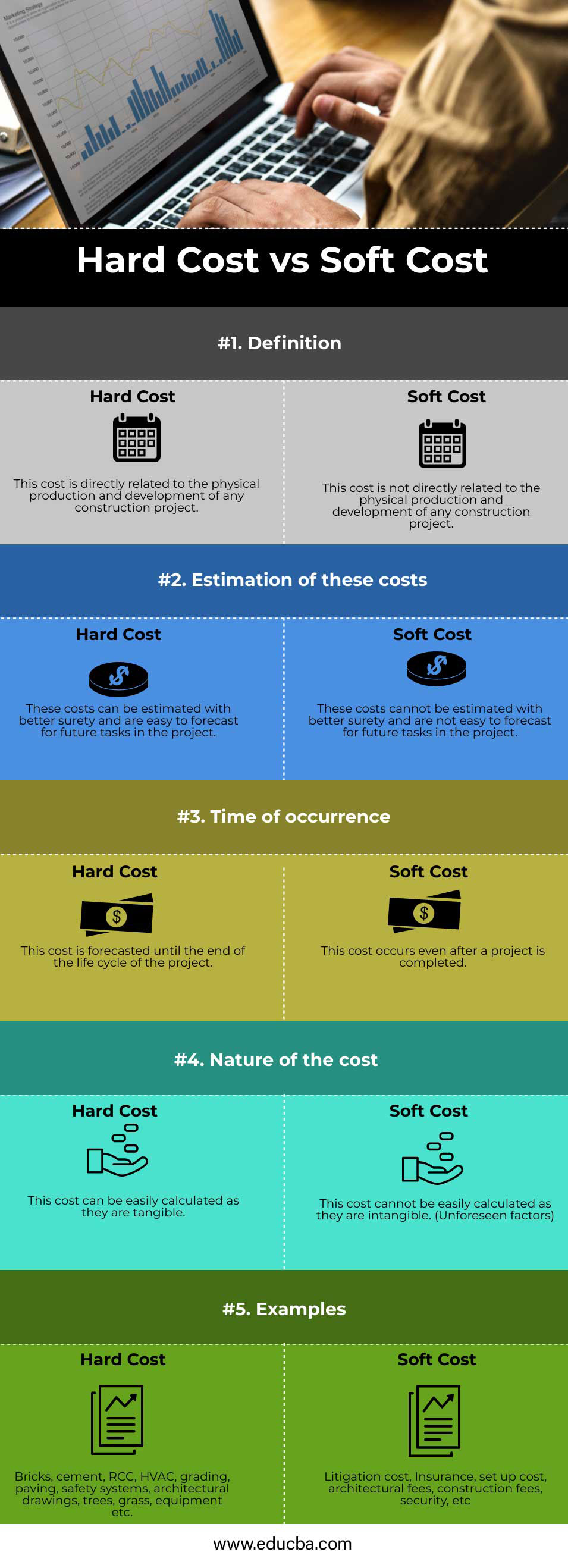Updated July 25, 2023

Difference Between Hard Cost vs Soft Cost
The name hard and soft cost is generally given for real sector companies. In the construction industry, when we talk to contractors, developer these are the specific words used. While preparing a budget for construction, the expenses are generally dealt with these two terms-hard and soft costs. Conceptual budgeting helps us to lower the risk associated with the project.
What is Hard Cost?
The other name for the hard cost is ‘brick and mortar cost’. Hard costs simply mean construction costs. These costs are generally fixed or can be estimated. e.g. Estimating the quantity of steel need for a particular structural design. It relates to the site and the landscape. These are the cost which you cannot avoid. Hard cost varies widely in markets, e.g. Cost of cement would be higher in one state than the other. The hard cost usually accounts for about 70 percent of the total cost of construction.
The hard cost can be quantifiable by having conceptual planning of the project. During this phase, the efficiency would be as low as 50 percent. In the next step, an estimator can get into details about the past bid, approved the budget. This stage gives around 65-70 percent accuracy level. Once this is done final estimation is based upon complete plans, specifications, contracts, bids, etc. We can be as sure as 85 percent of estimating hard costs.
What is Soft Cost?
Anything and everything which is not directly linked with the production and development of any construction project is known as soft cost. The cost, which is indirectly linked with construction, comes under this class. The soft cost is variable, e.g. Advertising can be initially done by mouth publicity and later turned to digital. The cost that can occur even after completion of construction, e.g., Maintenance cost. The soft cost makes up 30 percent of the entire construction cost.
The soft cost can be estimated by keeping a percentage lumpsum amount aside. These costs could be for architectural and design fees, inspection fees, land and real estate cost, loans, rental tools, project management, local and state taxes, surveys, feasibility studies cost, etc. It is wise to allocate a higher share for soft cost as it is unusual, and you never know what would occur when. The soft cost can give a harder hit to the bottom line of the statement. New laws in construction have also led to a rise in soft costs, e.g., LEED certifications for building.
Head To Head Differences Between Hard Cost vs Soft Cost (Infographics)
Below are the top 5 differences between Hard Cost vs Soft Cost:
Key Differences Between Hard Cost vs Soft Cost
Let us discuss some of the major Difference Between Hard Cost vs Soft Cost:
- In the real estate world, the hard cost simply means the cost directly needed for the completion of any project. Example: Just assume you are a contractor and want to build a building. What is direct cost will you take into account? The cost can be seen. E.g. Bricks, sand, motor, steel, water, PCC, Labours, etc. These costs directly links with your development and production. The more floors you construct greater would be the hard cost. On the other hand, soft costs are those which you can never be sure about from the initial phase. Suppose before even starting the construction, the land is under some dispute, and the case is gone under investigation. Here you are not sure how much would be the cost or how many times will such a situation repeat. Hence, soft cost becomes too difficult to calculate.
- The hard cost can be estimated by an experienced person but varies depending upon the type of project. For hospitals, hard costs would be too high compared to that of a residential building. The soft cost cannot be estimated easily. As it varies from project to project and is very uncertain.
- The major difference between these two costs is the time frame to calculate the cost. The hard cost occurs until the end of any project’s construction phase, whereas the soft cost may occur even after the construction phase. There are some documentations, Permissions, and certifications like occupancy certificates needed to be done even after the project is completed come under soft cost. Once the project is complete, one doesn’t need any cost for equipment, plants, machinery, raw materials, labor, etc.
- Hard cost is the tangible cost. An experienced person can easily calculate the cost. Soft cost is not visible by the eyes and is not obvious to the client at first. These costs are not related to labor or material, or equipment. E.g., Soft cost includes taxes, permits, advertising costs, etc. Soft cost may also include movable furniture as it could be transferred.
Hard Cost vs Soft Cost Comparison Table
Let’s discuss the top comparison between Hard Cost vs Soft Cost
| Basic Comparison Point |
Hard Cost |
Soft Cost |
| Definition | This cost is directly related to the physical production and development of any construction project. | This cost is not directly related to the physical production and development of any construction project. |
| Estimation of these Costs | These costs can be estimated with better surety and are easy to forecast for future tasks in the project. | These costs cannot be estimated with better surety and are not easy to forecast for future tasks in the project. |
| Time of Occurrence | This cost is forecasted until the end of the life cycle of the project. | This cost occurs even after a project is completed. |
| Nature of the Cost | This cost can be easily calculated as they are tangible. | This cost cannot be easily calculated as they are intangible. (Unforeseen factors) |
| Examples | Bricks, cement, RCC, HVAC, grading, paving, safety systems, architectural drawings, trees, grass, equipment, etc. | Litigation cost, Insurance, set up cost, architectural fees, construction fees, security, etc. |
Conclusion
Construction cost impacts the rate of return on the investment made. So, before analyzing and concluding, one needs to thoroughly go through all the cost components of the project. Whether the cost fits into the hard or soft category. The key to a successful project or investment is a well-planned budget. Construction cost directly impacts the rent and overall return of investment. So, it is always advisable to have a clear and detailed breakdown of the project. This task seems challenging, but having an experienced person and going through the historic files and knowledge can stop himself by making huge mistakes. Any construction project comes with its own unique sets of risks. The more detailed and accurate the estimate is lesser are the chances of failure.
Recommended Articles
This is a guide to Hard Cost vs Soft Cost. Here we discuss the Hard Cost vs Soft Cost key differences with infographics and a comparison table. You can also go through our other suggested articles to learn more –


